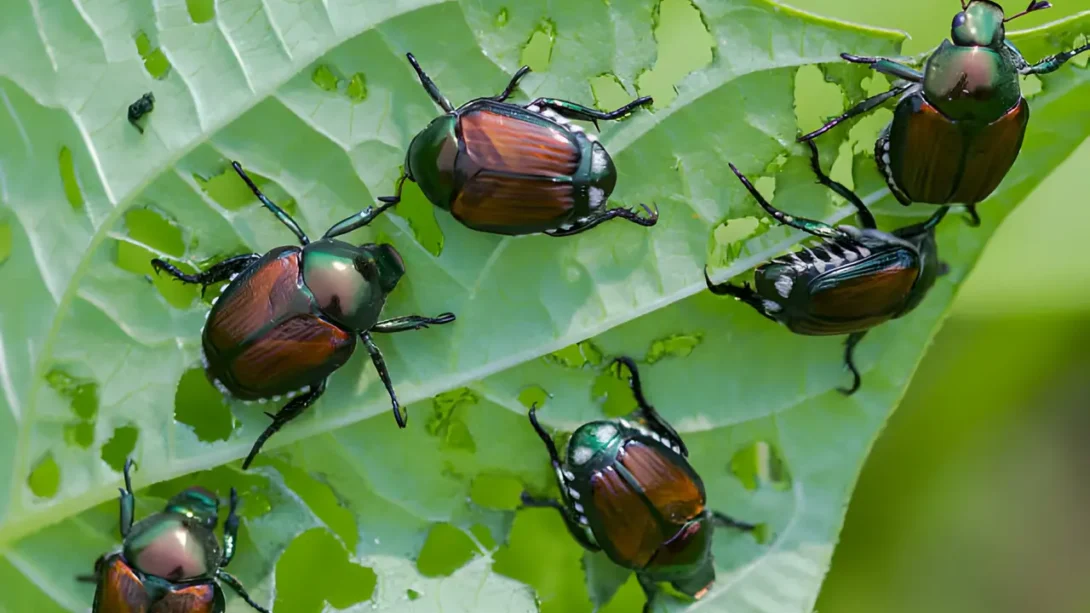Japanese beetles (Popillia japonica) are a familiar sight in many gardens across the United States, and their presence is often met with dismay by gardeners and farmers alike. Originating from Japan, these beetles were first identified in the United States in 1916, and since then, they have spread to cover a vast area across the country. This invasive species is known for its broad appetite, targeting a wide range of plants, which raises the question of their impact on gardens and agricultural settings. This article aims to explore the extent of harm Japanese beetles can cause and shed light on effective management practices.
Identification of Japanese Beetles
Japanese beetles are easily identifiable by their metallic green bodies and copper-colored wings. Adults are about 1/2 inch in length, making them a visible pest in the garden. They are most active during warm, sunny days and are often found in groups, feasting on the leaves, flowers, and fruits of their host plants. These beetles have a life cycle that begins with eggs laid in the soil during summer, progressing to grubs that feed on grassroots in the fall, and then emerge as adults the following summer. Understanding their life cycle is crucial for effective control measures.
The Impact on Plants and Crops
Japanese beetles are not picky eaters; they target over 300 species of plants, including roses, grapes, beans, and many types of fruit trees. The damage is unmistakable – leaves are skeletonized, flowers are devoured, and fruits are scarred, making them unmarketable. This not only affects the aesthetic appeal of gardens but can significantly reduce the yield and quality of crops in agricultural settings. In severe infestations, plants can become so damaged that they are unable to photosynthesize effectively, leading to stress and potential death. The widespread appetite of Japanese beetles makes them a formidable pest to a diverse range of plant species, highlighting the importance of identifying and addressing infestations promptly.
Ecological Impact
The presence of Japanese beetles in non-native environments poses significant risks to local ecosystems. Their feeding habits can disrupt the natural balance, leading to a decrease in biodiversity. Native plants, often not evolved to withstand the feeding frenzy of these invaders, can be severely impacted, which in turn affects the native fauna dependent on these plants for food and habitat. Furthermore, Japanese beetles can act as vectors for plant diseases, spreading them from one plant to another as they feed, exacerbating the challenges faced by both natural and cultivated landscapes.
Management and Control Methods
Managing Japanese beetle populations requires a multi-faceted approach that combines preventative measures, biological control, chemical treatments, and cultural practices. Preventative measures include regular monitoring of plants for early signs of infestation and maintaining healthy gardens to resist beetle damage. Biological control methods, such as introducing natural predators like birds or beneficial insects that feed on Japanese beetle larvae, can help reduce their numbers without the use of chemicals.
Chemical treatments, while effective, should be considered carefully due to potential impacts on non-target species and the environment. Insecticides may offer immediate relief from beetle damage but can also harm beneficial insects and contribute to chemical resistance over time. As such, they are recommended as a last resort and should be applied according to label instructions to minimize risks.
Cultural practices play a crucial role in managing Japanese beetle populations. Proper lawn care, including aeration and timely watering, can discourage females from laying eggs in the soil. Removing diseased and weakened plants promptly reduces the overall attractiveness of the area to beetles. Additionally, covering susceptible plants with fine netting during peak beetle activity can provide a physical barrier against damage.
Alternative Strategies for Gardeners
Gardeners can adopt several strategies to minimize the impact of Japanese beetles without relying heavily on chemical controls. Selecting plant varieties that are less attractive to Japanese beetles can reduce the likelihood of infestation. Establishing trap crops—plants that beetles prefer, located away from the main garden—can lure them away from more valuable plants.
Natural repellents, such as neem oil or chrysanthemum-based insecticides (pyrethrins), offer organic alternatives to synthetic chemicals. These products can deter beetles when applied regularly, though their effectiveness may vary with weather conditions and beetle population size. Additionally, encouraging the presence of natural predators and beneficial insects by planting diverse gardens and avoiding broad-spectrum insecticides can help keep beetle numbers in check.
Community-Wide Management Efforts for Greater Impact
In areas heavily affected by Japanese beetles, community-wide efforts can significantly enhance the effectiveness of control measures. By coordinating actions such as synchronized planting, trapping, and treatment applications, communities can reduce the overall beetle population more effectively than individual efforts alone. Sharing knowledge and resources, like bulk purchasing of beneficial nematodes or organizing community spraying programs with environmentally safe products, can make a substantial difference in managing beetle infestations on a larger scale.
Conclusion
Japanese beetles (Popillia japonica) present a formidable challenge to gardeners, farmers, and ecosystems due to their broad appetite and the significant damage they can inflict on a wide range of plants. While they are harmful to plants and local biodiversity, understanding their lifecycle, habits, and the variety of management strategies available can empower individuals and communities to take effective action. By combining preventative measures, biological controls, responsible chemical use, and cultural practices, it’s possible to mitigate the impact of these invasive pests.
Encouraging responsible and sustainable gardening practices is crucial for not just combating Japanese beetles but also for preserving the health and diversity of our gardens and ecosystems. The fight against Japanese beetles is a reminder of the importance of balance in nature and the role every gardener plays in maintaining that balance. Through informed, community-driven efforts, we can protect our plants and contribute to a healthier, more biodiverse environment.




